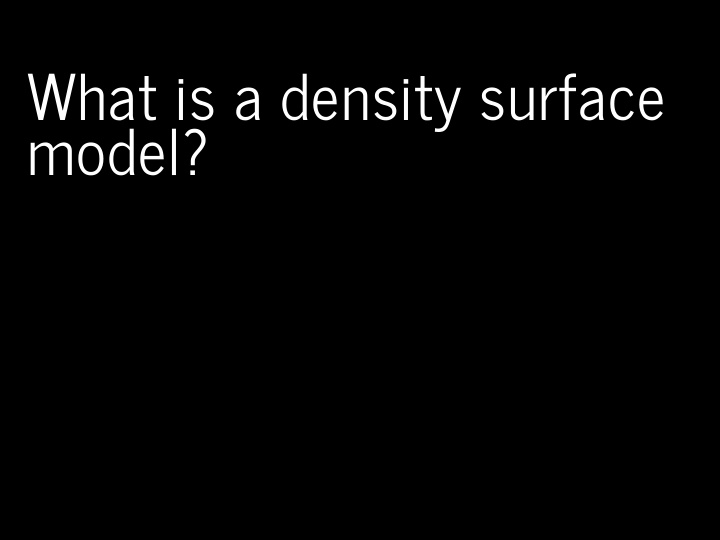



What is a density surface model?
Why model abundance spatially? Use non-designed surveys Use environmental information Maps
Back to Horvitz-Thompson estimation
Horvitz-Thompson-like estimators Rescale the (flat) density and extrapolate n study area s i covered area ∑ ^ = N ^ i p i =1 are group/cluster sizes s i is the detection probability (from detection ^ i p function)
Hidden in this formula is a simple assumption Probability of sampling every point in the study area is equal Is this true? Sometimes. If (and only if) the design is randomised
Many faces of randomisation
Randomisation & coverage probability H-T equation above assumes even coverage (or you can estimate)
Extra information
Extra information - depth
Extra information - depth NB this only shows segments where counts > 0
Extra information - SST
Extra information - SST (only segments where counts > 0)
You should model that
Modelling outputs Abundance and uncertainty Arbitrary areas Numeric values Maps Extrapolation (with caution!) Covariate effects count/sample as function of covars
Modelling requirements Include detectability Account for effort Flexible/interpretable effects Predictions over an arbitrary area
Accounting for effort
Effort Have transects Variation in counts and covars along them Want a sample unit w/ minimal variation “Segments”: chunks of effort
Chopping up transects Physeter catodon by Noah Schlottman
Flexible, interpretable effects
Smooth response
Explicit spatial effects
Predictions
Predictions over an arbitrary area Don't want to be restricted to predict on segments Predict within survey area Extrapolate outside (with caution) Working on a grid of cells
Detection information
Including detection information Two options: adjust areas to account for effective effort use Horvitz-Thompson estimates as response
Effective effort Area of each segment, A j use ^ j A j p think effective strip width ( ) ^ = w ^ μ p Response is counts per segment “Adjusting for effort” “Count model”
Estimated abundance Estimate H-T abundance per segment Effort is area of each segment “Estimated abundance” per segment s i ∑ ^ j = n ^ i p i in segment j
Detectability and covariates 2 covariate “levels” in detection function “Observer”/“observation” – change within segment “Segment” – change between segments “Count model” only lets us use segment-level covariates “Estimated abundance” lets us use either
When to use each approach? Generally “nicer” to adjust effort Keep response (counts) close to what was observed Unless you want observation-level covariates These can make a big difference!
Availability, perception bias and more is not always simple! ^ p Availability & perception bias somehow enter We can make explicit models for this More later in the course
DSM flow diagram
Spatial models
Abundance as a function of covariates Two approaches to model abundance Explicit spatial models When: good coverage, fixed area “Habitat” models (no explicit spatial terms) When: poorer coverage, extrapolation We'll cover both approaches here
Data requirements
What do we need? Need to “link” data Distance data/detection function Segment data Observation data to link segments to detections
Example of spatial data in QGIS
Recap Model counts or estimated abundace The effort is accounted for differently Flexible models are good Incorporate detectability 2 tables + detection function needed
Recommend
More recommend